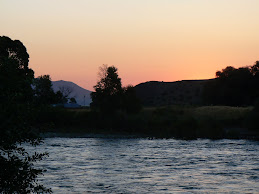The last big land give-away in the US began here at Arkansas City in 1893. About 110,000 people lined up to grab 40,000 parcels of free land. I found the most interesting thing about the Cherokee Strip land rush to be the giving away of land which had already been given to the Cherokee Indians as they were pushed out of their native area to the east. The Cherokee strip was the tribe's access to their hunting grounds in the West.

But the old Chisholm Trail cut through it as Texas longhorns were driven north to the railheads in Wichita and other Kansas cities and it was noted to be good grazing land. Sadly, it wasn't long before it looked too good for Indian land.

Ark City's small but interesting museum is dedicated to the story of the Cherokee Strip land rush.

People came to the area as much as two years in advance of the actual land rush, since registration was required before one was eligible to ride in the race, and registration could take many months. I'm truly awed thinking of people making that kind of commitment and the hardship it entailed.
But it was a chance to fulfill the dream of a home and some land for many people and there were 40,000 winners that day.
Here's Chorro trying to pick up the scent of the land rush.

Ponca City, Oklahoma, just across the border from Ark City, has a museum honoring the Pioneer Woman. I loved this beautiful statue in the front.

The museum's entrance is constructed in the shape of a pioneer woman's bonnet.
It's a little difficult to see in this picture, but the dark area in the center projects outward and acts as a huge sunshade when you are standing in the doorway looking out.

I was a little disappointed in the meager display inside, but this is a new museum and will in the future, I hope, add historical memorbilia to their pictures of the Miss Americas from Oklahoma, which really didn't project "pioneer woman" to me.
And a brief stop at the museum of the American Cafe' Latte' Society.
 The two museums bring to mind my grandmother, who homesteaded with my grandfather on the Saskatchewan prairie in Canada around the turn of the twentieth century. She was born in 1867 in Germany and came to Canada with her husband and several children on an amazing adventure. However, I think the cold Canadian winters chilled the enthusiasm of many would-be land owners and the rush in Canada was more like the trickle of melting snow, with land available for homesteading into the 1930's and perhaps 40's or later.
The two museums bring to mind my grandmother, who homesteaded with my grandfather on the Saskatchewan prairie in Canada around the turn of the twentieth century. She was born in 1867 in Germany and came to Canada with her husband and several children on an amazing adventure. However, I think the cold Canadian winters chilled the enthusiasm of many would-be land owners and the rush in Canada was more like the trickle of melting snow, with land available for homesteading into the 1930's and perhaps 40's or later. My father wasn't a homesteader, but he was a farmer, raising wheat and Hereford cattle on the Saskatchewan prairies. Late this summer, I had the opportunity to "go home." And I can't resist sneaking in a picture or two of that trek right here.
 Here's a picture of the farmhouse I grew up in, some changes, some things still the same.
Here's a picture of the farmhouse I grew up in, some changes, some things still the same. 
And here's the Canadian sunset that graced those long summer days of childhood, captured the same evening I visited, from the front yard of my childhood home.

And tomorrow is a new day.

2 comments:
Oh Auntie Vee, the picture of the house you grew up in made me cry. How old were you when you all lived there? Was that where you lived when Mom was born? Your story of your memories of the day she was born have really stuck with me. How poignant it must have been for you to see your childhood home and all the memories it must have evoked. What a beautiful sunset.
Thank you for sharing.
Jeanne
Jeanne,
That is the house we lived in when your mother was born. We left when I was 13, your mother 9. If you look closely you can see little children around the house. The family that lives there now has 9 children (we had 10). The trees in front of the house and the addition came after we left.
Auntie Vee
Post a Comment